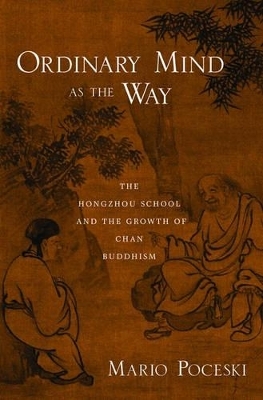
Ordinary Mind as the Way
The Hongzhou School and the Growth of Chan Buddhism
Seiten
2007
Oxford University Press Inc (Verlag)
978-0-19-531996-5 (ISBN)
Oxford University Press Inc (Verlag)
978-0-19-531996-5 (ISBN)
This is a comprehensive study of Hongzhou school, which under the leadership of Mazu Daoyi (709-788) and his disciples emerged as the dominant tradition of Chan (Zen) Buddhism in China during the middle part of the Tang dynasty (618-907).
Under the leadership of Mazu Daoyi (709-788) and his numerous disciples, the Hongzhou School emerged as the dominant tradition of Chan (Zen) Buddhism in China during the middle part of the Tang dynasty(618-907). Mario Poceski offers a systematic examination of the Hongzhou School's momentous growth and rise to preeminence as the bearer of Chan orthodoxy, and analyzes its doctrines against the backdrop of the intellectual and religious milieus of Tang China. Poceski
demonstrates that the Hongzhou School represented the first emergence of an empire-wide Chan tradition that had strongholds throughout China and replaced the various fragmented Schools of early Chan
with an inclusive orthodoxy. Poceski's study is based on the earliest strata of permanent sources, rather than on the later apocryphal "encounter dialogue" stories regularly used to construe widely-accepted but historically unwarranted interpretations about the nature of Chan in the Tang dynasty. He challenges the traditional and popularly-accepted view of the Hongzhou School as a revolutionary movement that rejected mainstream mores and teachings, charting a new path for
Chan's independent growth as a unique Buddhist tradition. This view, he argues, rests on a misreading of key elements of the Hongzhou School's history. Rather than acting as an unorthodox movement,
the Hongzhou School's success was actually based largely on its ability to mediate tensions between traditionalist and iconoclastic tendencies. Going beyond conventional romanticized interpretations that highlight the radical character of the Hongzhou School, Poceski shows that there was much greater continuity between early and classical Chan-and between the Hongzhou School and the rest of Tang Buddhism-than previously thought.
Under the leadership of Mazu Daoyi (709-788) and his numerous disciples, the Hongzhou School emerged as the dominant tradition of Chan (Zen) Buddhism in China during the middle part of the Tang dynasty(618-907). Mario Poceski offers a systematic examination of the Hongzhou School's momentous growth and rise to preeminence as the bearer of Chan orthodoxy, and analyzes its doctrines against the backdrop of the intellectual and religious milieus of Tang China. Poceski
demonstrates that the Hongzhou School represented the first emergence of an empire-wide Chan tradition that had strongholds throughout China and replaced the various fragmented Schools of early Chan
with an inclusive orthodoxy. Poceski's study is based on the earliest strata of permanent sources, rather than on the later apocryphal "encounter dialogue" stories regularly used to construe widely-accepted but historically unwarranted interpretations about the nature of Chan in the Tang dynasty. He challenges the traditional and popularly-accepted view of the Hongzhou School as a revolutionary movement that rejected mainstream mores and teachings, charting a new path for
Chan's independent growth as a unique Buddhist tradition. This view, he argues, rests on a misreading of key elements of the Hongzhou School's history. Rather than acting as an unorthodox movement,
the Hongzhou School's success was actually based largely on its ability to mediate tensions between traditionalist and iconoclastic tendencies. Going beyond conventional romanticized interpretations that highlight the radical character of the Hongzhou School, Poceski shows that there was much greater continuity between early and classical Chan-and between the Hongzhou School and the rest of Tang Buddhism-than previously thought.
Mario Poceski is Assistant Professor of Buddhist Studies and Chinese Religions at the University of Florida
Abbreviations and Conventions
Introduction
Part I: History
1: The Life and Times of Mazu Daoyi
2: Regional Spread of the Hongzhou School
3: The Hongzhou School and Mid-Tang Chan
Part II: Doctrine and Practice
4: Doctrinal Contexts and Religious Attitudes
5: Mind, Buddha, and the Way
6: Path of Practice and Realizations
Conclusion
Appendix
Glossary
Bibliography
Index
| Erscheint lt. Verlag | 3.5.2007 |
|---|---|
| Zusatzinfo | 3 halftones, 1 line illus. |
| Verlagsort | New York |
| Sprache | englisch |
| Maße | 234 x 156 mm |
| Gewicht | 594 g |
| Themenwelt | Geisteswissenschaften ► Religion / Theologie ► Buddhismus |
| ISBN-10 | 0-19-531996-6 / 0195319966 |
| ISBN-13 | 978-0-19-531996-5 / 9780195319965 |
| Zustand | Neuware |
| Haben Sie eine Frage zum Produkt? |
Mehr entdecken
aus dem Bereich
aus dem Bereich
Philosophische Betrachtungen
Buch | Softcover (2024)
Aufbau TB (Verlag)
CHF 20,95
Unterweisungen in Zen-Meditation
Buch | Hardcover (2024)
Arkana (Verlag)
CHF 29,90


